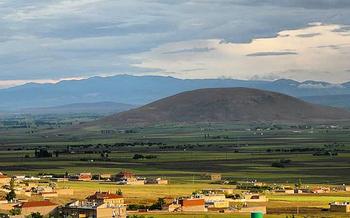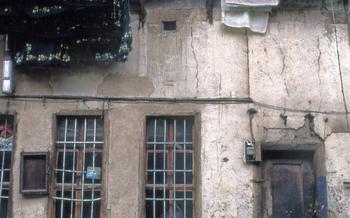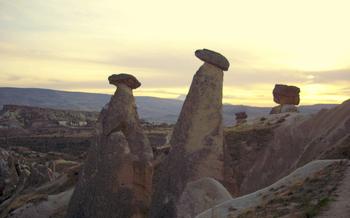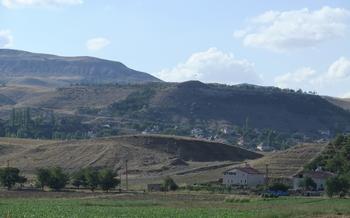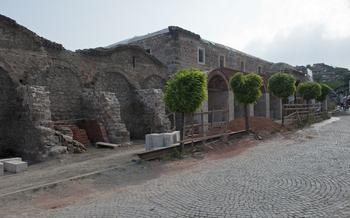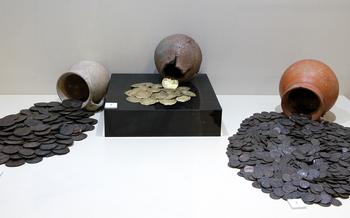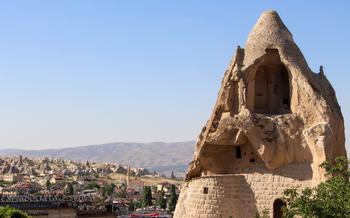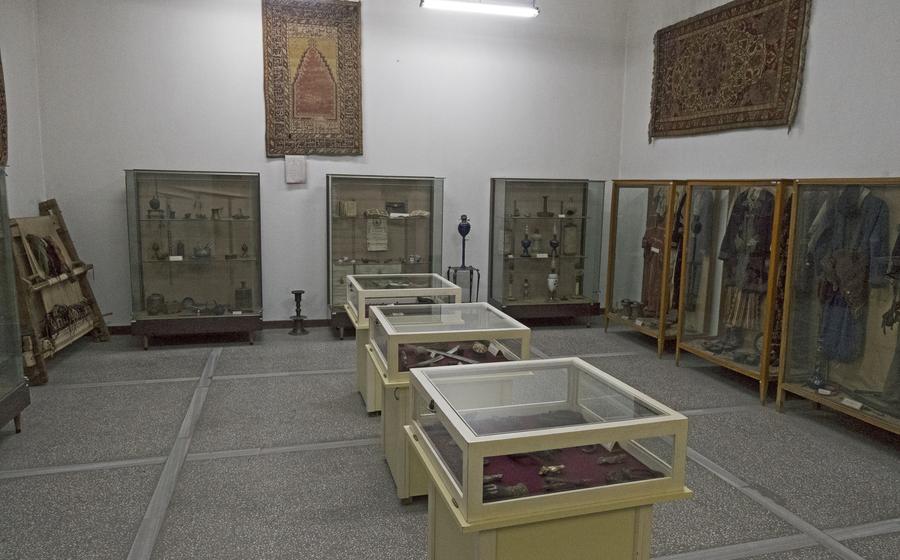
Museum of Urgup
- Historical Background
- Museum Overview
- Exhibits and Collections
- Cappadocian Culture
- Interactive Displays
- Educational Programs
- Architecture and Design:
- Temporary Exhibitions
- Accessibility and Facilities
- Photography and Social Media
- Local Festivals and Events
Historical Background
Urgup, nestled in the heart of Cappadocia, boasts a rich and diverse history that dates back to ancient times. As a major trading center along the Silk Road, Urgup played a pivotal role in the exchange of goods and ideas between the East and the West. The city's strategic location attracted various civilizations throughout history, each leaving its unique imprint on the region's cultural tapestry.
The Hittites, one of the earliest civilizations to inhabit Cappadocia, established their presence in Urgup around 1600 BC. They left behind impressive architectural remains, including rock-cut dwellings and fortifications, that testify to their engineering prowess. The Romans, who conquered Cappadocia in the 1st century BC, introduced their own architectural style, evident in the ruins of churches and public buildings.
The Byzantines, who ruled the region from the 4th to the 11th century AD, transformed Urgup into a thriving center of Christianity. They built numerous churches and monasteries, many of which have survived to this day and continue to attract visitors from around the world. The Ottomans, who conquered Cappadocia in the 15th century AD, brought with them their own cultural influences, which can still be seen in the city's mosques, madrasahs, and traditional houses.
Museum Overview
The Museum of Urgup stands as a testament to the rich cultural heritage of the Cappadocia region. Established to preserve and showcase the region's diverse history, the museum houses a treasure trove of artifacts, traditional costumes, and handicrafts that narrate the story of Urgup's past. With modern facilities, interactive exhibits, and educational programs, the museum offers a captivating and immersive journey through time. Visitors can delve into the region's ancient roots, explore the influence of various civilizations, and gain a deeper understanding of the unique cultural tapestry that defines Cappadocia.
Exhibits and Collections
The Museum of Urgup houses a diverse collection of artifacts that tell the story of the region's rich history and cultural heritage. Archaeological findings, traditional costumes, and exquisite handicrafts are carefully displayed, offering visitors a glimpse into the lives and traditions of the people who have inhabited this land.
Among the must-see artifacts are the intricate pottery pieces that showcase the region's renowned craftsmanship. The delicate patterns and vibrant colors of these ceramics reflect the influence of various civilizations that have passed through Cappadocia. Equally impressive are the traditional costumes, which display the unique style and artistry of the local population. From ornate headwear to finely embroidered garments, these costumes provide a glimpse into the region's rich textile traditions.
The museum also houses a collection of handmade carpets, renowned for their intricate designs and vibrant hues. These carpets, woven by skilled artisans using traditional techniques, are not only beautiful works of art but also hold cultural significance, reflecting the nomadic heritage of the region.
Beyond these highlights, the museum's collection encompasses a wide range of other artifacts, including ancient tools, religious objects, and everyday items that shed light on the daily lives of the people who have called Cappadocia home. Each artifact, carefully curated and displayed, contributes to the museum's mission of preserving and showcasing the region's rich cultural heritage.
Cappadocian Culture
The Museum of Urgup offers a fascinating glimpse into the unique culture and traditions of Cappadocia, a region shaped by a blend of nomadic and settled populations. The exhibits showcase the influence of these diverse groups on the region's cultural heritage, from traditional costumes and jewelry to intricate handicrafts. Visitors can learn about the nomadic lifestyle of the early inhabitants, who roamed the vast plains with their herds of animals, and the contributions of settled communities that developed agriculture and trade. The museum also highlights the significance of local crafts, such as pottery, carpet weaving, and metalworking, which continue to thrive in the region and are a testament to the enduring skills and creativity of the Cappadocian people.
Interactive Displays
The Museum of Urgup employs a range of interactive exhibits to captivate visitors and bring the region's history to life. These immersive displays enhance the learning experience, making the museum accessible and engaging for a diverse audience.
Touchscreen panels provide visitors with in-depth information about the artifacts on display, allowing them to explore the historical context and significance of each item. Audio guides, available in multiple languages, offer guided tours through the museum, narrating the stories behind the exhibits and providing insights into the region's rich heritage.
Virtual reality (VR) experiences transport visitors to the past, immersing them in the ancient world of Urgup and Cappadocia. Through VR, visitors can virtually explore historical sites, witness traditional rituals, and gain a deeper understanding of the region's cultural evolution.
These interactive elements not only enhance the visitor experience but also promote a deeper appreciation for the history and culture of Urgup and the Cappadocia region.
Educational Programs
The Museum of Urgup is dedicated to promoting cultural awareness and appreciation through its diverse educational programs. These programs are designed to cater to different age groups and interests, making the museum accessible to a wide range of visitors.
One of the highlights of the museum's educational offerings is its interactive workshops. These workshops provide hands-on experiences that allow visitors to engage with the region's history and culture in a meaningful way. Participants can learn traditional crafts, such as pottery, carpet weaving, and metalworking, under the guidance of skilled artisans.
The museum also organizes regular lectures and seminars featuring experts in various fields related to Cappadocian history, archaeology, and culture. These events offer visitors an opportunity to deepen their knowledge and gain insights from leading scholars and researchers.
For younger visitors, the museum has developed a range of educational activities that make learning about history fun and engaging. Interactive games, storytelling sessions, and guided tours tailored to children help bring the past to life and spark their curiosity.
By offering these educational programs, the Museum of Urgup plays a vital role in preserving and transmitting the rich heritage of Cappadocia to future generations.
Architecture and Design:
The Museum of Urgup is housed in a beautifully restored 19th-century mansion that blends traditional Ottoman architecture with modern design elements. The building's exterior features intricate stone carvings, arched windows, and a charming courtyard that invites visitors to step back in time. Inside, the spacious galleries and exhibition halls are adorned with high ceilings, exposed beams, and natural light that illuminates the artifacts on display.
The museum's design seamlessly integrates the old and the new, creating a harmonious environment that enhances the visitor experience. Traditional materials such as stone, wood, and ceramic tiles are used throughout the building, paying homage to the region's rich architectural heritage. At the same time, modern amenities and state-of-the-art display techniques ensure that the museum meets international standards and provides a comfortable and engaging experience for visitors.
Unique architectural features of the museum include a central atrium that connects the different exhibition spaces, allowing visitors to navigate the museum with ease. The use of glass panels and skylights maximizes natural light, creating a bright and airy atmosphere that complements the exhibits. The museum also incorporates elements of sustainable design, such as energy-efficient lighting and climate control systems, demonstrating its commitment to preserving the environment while providing a world-class cultural experience.
Temporary Exhibitions
In addition to its permanent collection, the Museum of Urgup also hosts a variety of temporary exhibitions throughout the year. These exhibitions showcase specific themes or highlight new acquisitions, offering visitors a fresh perspective on the region's history and culture.
Past temporary exhibitions have explored diverse topics such as the ancient art of Cappadocia, the nomadic traditions of the region, and the influence of Byzantine iconography. These exhibitions have drawn significant interest from both local and international visitors, providing a platform for emerging artists and scholars to showcase their work.
One notable temporary exhibition was titled "Colors of Cappadocia," which featured a collection of vibrant paintings and photographs capturing the unique landscapes and cultural heritage of the region. Another popular exhibition, "Women of Anatolia," celebrated the contributions of women in shaping the history and culture of Cappadocia.
Temporary exhibitions at the Museum of Urgup are a testament to the institution's commitment to promoting cultural exchange and fostering a deeper understanding of the region's rich heritage. Visitors are encouraged to check the museum's website or social media channels for information on upcoming exhibitions.
Accessibility and Facilities
The Museum of Urgup is committed to ensuring that all visitors have a comfortable and accessible experience. The museum is wheelchair accessible, with ramps and elevators throughout the building. Audio guides are available for visually impaired visitors, and the museum staff is trained to assist visitors with disabilities. Restrooms, cloakroom facilities, and parking options are available for visitors' convenience. The museum's facilities contribute to its accessibility and ensure that all visitors can enjoy the exhibits and learn about the rich history and culture of Urgup and Cappadocia.
Photography and Social Media
The Museum of Urgup encourages visitors to capture and share their experiences through photography, but kindly requests that they adhere to a few guidelines to ensure the preservation of the artifacts and a peaceful environment for all visitors. Flash photography is prohibited to avoid damaging the delicate artifacts. Visitors are also asked to refrain from using tripods or selfie sticks to prevent any accidental damage or disruption to other visitors.
The museum actively engages with its visitors on social media and encourages them to share their photos and experiences using the designated hashtag #MuseumOfUrgup. By tagging the museum's official social media accounts, visitors can contribute to the museum's online community and connect with fellow travelers who share their passion for history and culture.
Local Festivals and Events
Urgup and the Cappadocia region are renowned for their vibrant festivals and events that showcase the local culture and traditions. These events offer an immersive experience for visitors to delve deeper into the region's rich heritage and connect with its people. One of the most popular festivals is the Urgup International Art Festival, held annually in June. This festival brings together artists from around the world to showcase their talents in various forms, including painting, sculpture, photography, and music. Visitors can admire stunning artworks, participate in workshops, and enjoy live performances during this vibrant celebration of creativity.
Another highlight is the Cappadocia Hot Air Balloon Festival, which takes place in September. This spectacular event fills the skies with hundreds of colorful hot air balloons, creating a magical and unforgettable sight. Visitors can take to the skies themselves for a breathtaking bird's-eye view of the Cappadocian landscape, dotted with unique rock formations and ancient settlements.
To experience the region's rich culinary heritage, visitors can attend the Urgup Food Festival, held in October. This festival celebrates the diverse flavors of Cappadocian cuisine, with stalls offering a variety of local delicacies, such as gözleme (stuffed flatbreads), manti (Turkish dumplings), and keşkek (a traditional wheat and meat dish). Visitors can indulge in culinary delights while enjoying live music and performances.
By planning their visit to coincide with one of these local festivals or events, visitors can enhance their experience of Urgup and the Cappadocia region, immersing themselves in the vibrant culture and traditions that make this part of Turkey so special.

